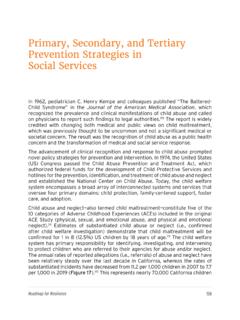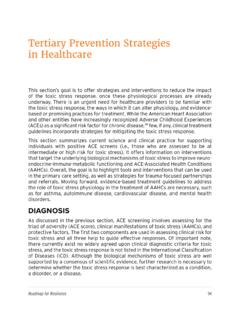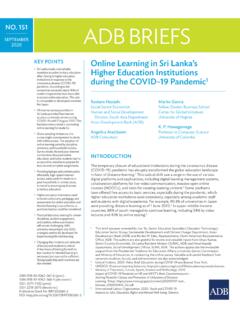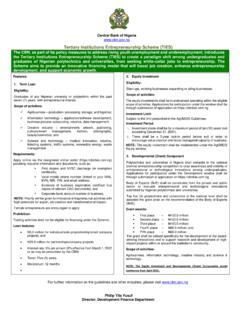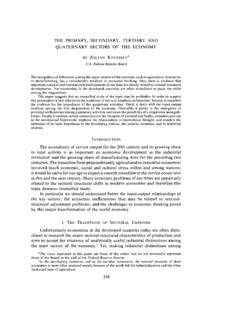Transcription of Primary, Secondary, and Tertiary Prevention Strategies in ...
1 primary , secondary , and Tertiary Prevention Strategies in public HealthThe public health sector s long-standing mission is to promote and protect the health and well-being of entire populations, to seek to prevent disease and injuries before they happen, and to mitigate health consequences once disease, injury, or disaster does strike. In general, the professional field is led by the network of national, state, and local governmental public health agencies and supported by a wide range of academic, public , and private partners conducting research, implementing and evaluating population-level interventions and advocating for public health solutions. The public health field emphasizes a broad perspective that includes the social, economic, and political determinants of health and recognizes and prioritizes the non-medical contextual factors influencing health outcomes.
2 To carry out its mission, the public health field strives to deliver 10 essential public health services:1081,10821. Assess and monitor population health, factors that influence health, and community needs and assets;2. Investigate, diagnose, and address health hazards and root causes;3. Communicate effectively to inform and educate about health, factors that influence it and, how to improve it, for the public at large, and for specific sectors about their roles in Prevention , early detection, and treatment;4. Strengthen, support, and mobilize communities and partnerships to improve health, including strong cross-sector referral networks and community partnerships to respond to health risks;5. Create, champion, and implement policies, plans, and laws that impact health, including equitable access to resources needed for health promotion, Prevention of health risks, and to early identification and treatment of recognized health conditions;6.
3 Utilize legal and regulatory actions designed to improve and protect the public s health;7. Assure an effective system that enables equitable access to the individual services and care needed to be healthy, including for primary , secondary , and Tertiary Prevention of health risks;Roadmap for Resilience1318. Build and support a diverse and skilled public health workforce, including training for sector-specific personnel to understand their role in preventing and intervening on health risks, and Strategies for cross-sector coordination, including across the justice, healthcare, public health, social services, early childhood, and education sectors;9. Improve and innovate public health functions through ongoing surveillance, evaluation, research, and continuous quality improvement in the field of toxic stress, these include the work of consortia such the Bay Area Research Consortium on Toxic Stress and Health; the JPB Research Network on Toxic Stress, and the PALS research network;1083-1085 and10.
4 Build and maintain a strong organizational infrastructure for public essential public health services provide the framework for public health to protect and promote the health of all people in all communities. Specifically, the framework utilizes a systematic approach to problem-solving with four general components:1. Define and monitor the health problem to be prevented or mitigated,2. Assure widespread adoption of known effective Prevention principles and Strategies ,1086-10883. Develop and test further Prevention Strategies , and4. Identify and seek to reduce risks and increase protective factors at each social-ecological level (individual, relationships, community, and society) across the life framework also offers a roadmap for public health work to address Adverse Childhood Experiences and toxic stress through primary , secondary , and Tertiary Prevention Strategies .
5 For example, public health surveillance ( , tracking health and disease patterns over time) and epidemiologic study ( , investigating risk and protective factors and evaluating effectiveness of interventions) provide critical data to inform policy, program, and practice decisions at all Prevention levels. In 2008, California became the first state to include the ACE module, adapted from the ACE Study by Kaiser Permanente and the Centers for Disease Control and Prevention (CDC), in the state s Behavioral Risk Factor Surveillance System (BRFSS).1090 Since then, most states have integrated an ACE module into their California currently collects ACE information on eight out of the 10 ACEs (neither type of neglect is included) in the BRFSS every other year (so far, 2009, 2011, 2013, 2015, 2017, and 2019).
6 27 In December 2012, California added ACEs as an indicator for Healthy Beginnings in the Let s Get Healthy California The BRFSS ACEs module collects information based on adult recollections of their Roadmap for Resilience132 public Health: Prevention Strategieschildhood experiences during the first 17 years of life and allows California to compare ACE prevalence with population-level data on other health outcomes, such as heart disease, cancer, and , because the BRFSS ACE module is based on adults recollections of their childhoods, it is a lagging indicator of ACE exposure that doesn t provide direct information about the current status of ACEs in California s children.
7 Therefore, public health surveillance seeks additional data sources to expand its monitoring of child adversity. The National Survey of Children s Health (NSCH), a population-based survey conducted by the US Census Bureau on behalf of the Maternal and Child Health Bureau of the Department of Health and Human Services, provides the most direct and timely assessment of childhood resilience and It asks about five of the original 10 ACEs; in total, the NSCH uses a set of eleven family, economic, and community indicators to ask parents about current adverse experiences to which their children (ages 0 17) have been The NSCH confirms that childhood adversity is common among California children.
8 Among all California children, have experienced at least one of the ACEs assessed in the NSCH that align with the ACEs evaluated in the original ACE Study. Out of California children with public insurance, ACE prevalence goes up to Fewer than half ( ) of California s publicly insured school-age children without ACEs demonstrate the qualities of flourishing assessed in the NSCH, including being curious and interested in learning new things, working to complete tasks begun (persistence), and staying calm when facing challenges (regulating emotions and behavior). For children experiencing two or more ACEs, this fraction is reduced to Maternal Infant Health Assessment (MIHA) survey adds an intergenerational perspective on early hardships and adversities, and asks about four of the original 10 ACEs, among eight total adversities.
9 MIHA surveys postpartum women (15 years and older) who deliver a live birth about their own childhood hardships prior to age 14 and their contemporaneous challenges during the current pregnancy. It is a collaborative effort of the Maternal, Child, and Adolescent Health Division and the Women, Infant, and Children Division of the California Department of public Health and the Center on Social Disparities in Health at the University of California, San Francisco. According to the 2013 2014 MIHA survey, one in four California women with a recent birth (25%) experienced two or more childhood hardships before age 14. Among young mothers ages 15 19, one-third (33%) experienced two or more hardships as children, compared with fewer than one-fifth (19%) of mothers ages 35 and older.
10 Statewide, an estimated 34% of postpartum women living at or below the federal poverty guideline were exposed to at least two childhood hardships, more than double the estimate (16%) for women with higher family incomes (above 200% of the federal poverty guideline).1095 See Appendix A for a Roadmap for Resilience133 public Health: Prevention Strategiessummary comparison of the three kinds of ACE surveys used in together, these three public health surveillance data sources provide a rich and conceptually related perspective that looks at child adversity across the lifespan, and useful data to inform and facilitate interventions. However, more timely community-level data are needed to provide detailed, integrated, and real-time information on risk and protective factors to inform policymakers and local community action.
